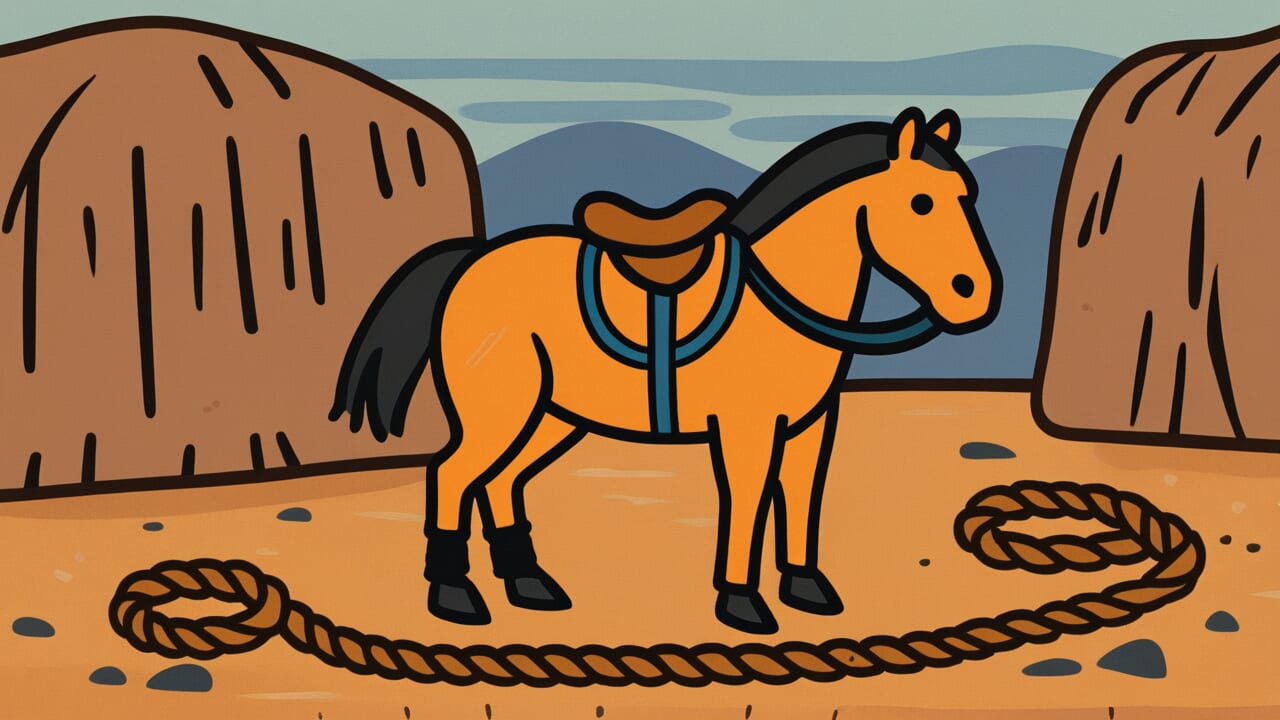How to Read “Tying a horse to a rotten rope”
Kusari nawa ni uma wo tsunagu
Meaning of “Tying a horse to a rotten rope”
“Tying a horse to a rotten rope” is a proverb that warns against the foolishness of entrusting something precious to something unreliable.
Just like tying a valuable horse with a rotten rope that could break at any moment, it represents the danger of leaving important matters to undependable people or uncertain methods.
This proverb is used when someone entrusts something important without a solid foundation.
For example, assigning critical work to a contractor with no track record, or leaving large sums of money with someone untrustworthy.
It points out situations that may seem fine on the surface but actually have a fragile foundation that could collapse at any time.
This teaching remains relevant today. In fact, in an age overflowing with information where it’s hard to know what to trust, we need to carefully evaluate who or what we entrust with important things.
If we’re attracted by immediate convenience or low cost and neglect to verify true reliability, we risk irreversible failure.
This is the warning this proverb gives us.
Origin and Etymology
No clear written records of this proverb’s origin seem to exist, but we can examine it through its component parts.
“Rotten rope” literally means a rope that has decayed and lost its strength.
In ancient Japan, people made rope from plant fibers like straw and hemp. These materials would rot from moisture and time, breaking easily.
Meanwhile, horses were precious assets essential to people’s lives for farming, transportation, and travel.
Horses in those days had value equivalent to modern automobiles. Losing one would severely disrupt daily life.
The danger of tying such a precious horse with a rotten rope that could break at any moment—this vivid contrast is the heart of this proverb.
If the horse escaped, finding it would be difficult. In the worst case, it might never return.
This expression likely arose from actual experiences in agricultural society.
For people who handled horses, checking the rope’s condition was absolutely basic.
Neglecting this and continuing to use a rotten rope was clear negligence. It was condemned as foolish behavior that invited irretrievable loss.
Usage Examples
- Entrusting a major contract to that company with its bad reputation is like tying a horse to a rotten rope
- Storing important data in the cloud without security measures is the same as tying a horse to a rotten rope
Universal Wisdom
Behind the continued telling of “Tying a horse to a rotten rope” lies insight into fundamental human weakness.
Everyone has a psychological tendency to avoid troublesome things.
Even when vaguely aware that a rope might be rotten, people postpone action thinking “It’s probably still okay” or “It’ll be fine just for today.”
They begrudge the effort of replacing it with new rope and skip the time needed for inspection.
This “oh well” complacency is exactly what causes great losses.
An even deeper problem is that people tend to underestimate danger.
The experience of nothing bad happening so far creates baseless confidence that “things will continue to be fine.”
Even with a rotten rope, the horse didn’t escape yesterday. So it’ll probably be okay today and tomorrow too.
But the rope grows steadily weaker each day, and one day it suddenly snaps.
What this proverb teaches is that to protect precious things, we must not neglect unglamorous, tedious inspection work.
Rather than flashy success, steady foundation-building is what truly matters.
This practical wisdom from our ancestors is condensed here.
Precisely because humans are creatures who fundamentally want to take the easy path, this warning continues to be needed across the ages.
When AI Hears This
A chain’s strength is determined by its weakest link. This is the weakest link theory in materials engineering.
The combination of a rotten rope and a horse provides an interesting example of this theory.
When measuring a rope’s tensile strength, healthy sections can withstand several hundred kilograms, but rotten sections break at just a few dozen kilograms.
So even if the horse’s force is 100 kilograms, if the rope’s weakest part can only withstand 50 kilograms, the entire system’s durability becomes 50 kilograms.
What’s important here is that even if 99 percent of the rope is healthy, just 1 percent of rot can render the whole thing useless.
Even more troublesome is the time element. Rot progresses moment by moment, and the rope’s strength continuously decreases.
Meanwhile, the force with which a horse pulls the rope is sudden and unpredictable.
If the force when the horse suddenly rears happens to exceed the rope’s strength at that moment, breakage occurs.
This combination of a “slowly weakening system” and “sudden loads” makes the timing of failure extremely difficult to predict.
In reliability engineering, such situations are analyzed as “interaction between degrading components and variable loads.”
The same principle operates in aircraft bolts and bridge cables. Finding the weakest parts through regular inspections is the core of safety management.
Lessons for Today
What this proverb teaches modern people is about “the responsibility to protect what matters.”
Around us are many precious things we must protect. Trust with family, careers built over years, health, savings, connections with friends.
Do you regularly check whether the foundations supporting these are truly solid?
Especially in modern society, convenience and speed are prioritized, and foundation inspections tend to be neglected.
Reusing passwords, postponing health checkups, leaving insurance unreviewed, insufficient maintenance of relationships.
All of these get pushed aside precisely because “problems won’t arise immediately.”
But think about it. What is your “horse”? And is the “rope” tying it truly strong?
What matters isn’t aiming for perfection. It’s having the habit of checking regularly.
Set aside time once a month to review your life’s foundations.
Just that can prevent many “irreversible failures.”
After all, the only one who can protect what’s precious to you is you yourself.



Comments